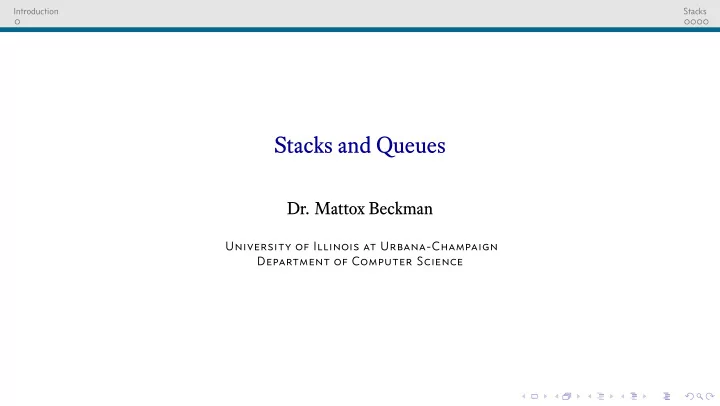

Introduction Stacks Stacks and Queues Dr. Mattox Beckman University of Illinois at Urbana-Champaign Department of Computer Science
Introduction Stacks Input and Output Your Objectives: ◮ You already know about these! But... ◮ We will cover the STL implementations. ◮ Also linked lists....
std :: cout << mystack.top() << '\n'; while ( ! mystack.empty()) { std :: cout << "mystack contains:\n"; mystack.pop(); mystack.emplace ("Second sentence"); } mystack.emplace ("First sentence"); std :: stack < std :: string > mystack; // std::string, std::getline(string) // std::cin, std::cout // std::stack Introduction Stacks ◮ Last in First out — O (1) access to top element only. ◮ Use in many algorithms. E.g., brace matching, strongest connected components. ◮ C++ built-in: push(x) , pop() , top() , empty() . 0 // stack::emplace -- from cplusplus.com/reference/stack 1 #include <iostream> 2 #include <stack> 3 #include <string> 4 5 int main () { 6 7 8 9 10 11 12 13 14 return 0; 15 }
Introduction Stacks Queues ◮ FIFO — used for BFS, scheduling, etc. ◮ STL Queues use a doubly ended underlying implementation by default. ◮ This gives you O (1) access to the front and the back. ◮ View: back() and top() ◮ Insert: push() . If you need explicit access, use deque directly. ◮ Do not use pointer arithmetic to access elements!
Introduction Stacks Lists ◮ There is a STL list class. ◮ For most problems you will not want to use this! ◮ Important exception: if you must do fast insertions in the middle of the list.
Introduction Stacks That’s it! ◮ There will be a problem set. Focus on two skills: ◮ Deciding quickly which data structure is appropriate, ◮ Using the STL versions of the data structures.
Recommend
More recommend